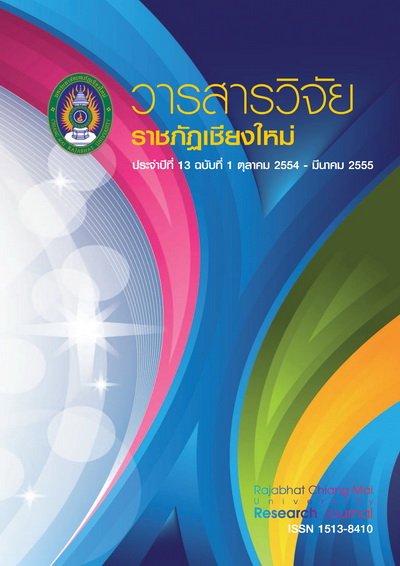เทคนิคการผลิตเครื่องฟ้นดินเผาแบบขัดมัน เพื่อการออกแบบผลิตภัณฑ์ร่วมสมัย
DOI:
https://doi.org/10.14456/rcmrj.2012.96085Keywords:
เครื่องปันดินเผาแบบขัดมัน, การออกแบบผลิตภัณฑ์, ผลิตภัณฑ์ร่วมสมัย, polished pottery, contemporary product design, Contemporary productsAbstract
การพัฒนาผลิตภัณฑ์เครื่องปันดินเผาแบบขัดมันร่วมสมัยในครั้งนี้มีวัตถุประสงค์ คือ 1) เพื่อศึกษาเทคนิคการผลิตเครื่องปันดินเผาแบบขัดมัน บ้านเหมืองถุงจังหวัดเชียงใหม่2 )เพื่อออกแบบผลิตภัณฑ์เครื่องปันดินเผาแบบขัดมันร่วมสมัย ให้เหมาะสมกับความต้องการของผู้บริโภคและสร้างมูลค่าเพิ่มให้ผลิตภัณฑ์ชุมชน กลุ่มตัวอย่างที่ใช้ในงานวิจัยครั้งนี้ คือ 1) ประชากร ได้แก่กลุ่มชาวบ้านผู้ผลิตเครื่องปันดินเผาบ้านเหมืองถุง อำเภอหางดง จังหวัดเชียงใหม่ จำนวน 2 กล่มตัวอย่างที่ทำการผลิตเครื่องปันดินเผา 2) กล่มตัวอย่าง ผู้ผลิตเครื่องปันดินเผาบ้านเหมืองกงหมู่ 7 ตำบลหนองควาย อำเภอหางดง จังหวัดเชียงใหม่ โดยการลุ่มตัวอย่าง
เทคนิคการผลิตเครื่องปันดินเผาแบบขัดมัน บ้านเหมืองถุง อำเภอหางดง จังหวัดเชียงใหม่ พบว่าแหล่งผลิตงานหัตถกรรมเครื่องปันดินเผาแบบขัดมัน มีการผลิตงานเครื่องปันดินเผาแบบขัดมันที่เป็นแหล่งใหญ่ที่สุดจำนวน 2 แหล่งที่ผลิต ซึ่งกระบวนการผลิตและใช้การขัดมันที่เป็นเอกลักษณ์เฉพาะของบ้านเหมืองถุง โดยเฉพาะผลิตภัณฑ์เครื่องปันดินเผาแบบคนโท หรือนํ้าด้น และหม้อนํ้า ที่เป็นที่ขึ้นชื่อของหมู่บ้านนี้ และเอกลักษณ์อย่างหนึ่งที่การเคลือบผิวด้วยนํ้าเคลือบสีแดงที่ได้มาจากดินแดงของอำเภอดอยสะเก็ด จังหวัดเชียงใหม่ โดยนำมาผสมกับนํ้าและนํ้ามันโซล่า
วัสดุและกรรมวิธีการผลิตเครื่องปันดินเผาแบบขัดมัน พบว่า การขึ้นรูปเครื่องปันดินเผา ในสมัยก่อนที่ยังไม่มืการขึ้นรูปจากแป้นหมุนได้มืการสร้างแป้นหมุนแบบชาวบ้านที่เรืยกกันว่า จ๊าก เป็นแป้นหมุนที่ทำมาจากไม้อัดแผ่นและไมไผ่โดยเป็นภูมิปัญญาของชาวบ้านเหมืองถุงและปัจจุบันยังมืให้เห็นอยู่เฉพาะบางบ้านที่ทำการผลิตเฉพาะคนโทนํ้า นํ้าหม้อ เพราะว่า จ๊าก จะสามารถขึ้นรูปผลิตภัณฑ์ที่มืขนาดเล็กได้อย่างเดียวแตกต่างกับการขึ้นรูปด้วยแป้นหมุนที่สามารถขึ้นรูปผลิตภัณฑ์ที่มืขนาดใหญ่ ๆ ได้ วัสดุหลักอีกประเภทหนึ่งที่ขึ้นชื่อให้กับชุมชนบ้านเหมืองถุงคือ นํ้าเคลือบสิแดงและเมื่อทำการเคลือบด้วยนํ้าเคลือบสิแดงแล้วทำการขัดมันโดยการใช้หินแม่นํ้าในการขัดให้ขึ้นเงาก่อนนำไปเผาในอุณหภูมิที่ตํ่าประมาณ 800 องศา ก็จะได้เครื่องปันดินเผาแบบขัดมันและเป็นเอกลักษณ์ของเครื่องปันดินเผาแบบล้านนา
ด้านกรรมวิธีการขึ้นรูปชิ้นงานเครื่องปันดินเผานั้นจำเป็นต้องมืความสอดคล้อง และเหมาะสมกับลักษณะรูปทรงและกรรมวิธีการผลิตที่ถูกต้อง เพื่อลดระยะเวลาในการผลิต และง่ายต่อการผลิต ต้านข้อมูลการตลาดงาน หัตถกรรมเครื่องปันดินเผาเพื่อใช้เป็นข้อมูลทางการออกแบบ พบว่า ผู้ซี้องานเครื่องปันดินเผาส่วนใหญ่เป็นเพศหญิงและชาย มีจำนวนพอๆกันมีอายุระหว่าง35-45ปี ส่วนใหญ่เลือกซื้อเครื่องปันดินเผาประเภทเครื่องใช้ภายในบ้าน รองลงมา ประเภทของที่ระลึก และของตกแต่งสวน ตามลำดับ ผู้บริโภคต้องการให้มีการพัฒนาประโยชน็!ช้สอยความสวยงาม รองลงมา การประยุกต็ใช้วัสดุอื่นเป็นส่วนประกอบของผลิตภัณฑ์
ต้านแนวความคิดในการออกแบบงานหัตถกรรมเครื่องปันดินเผาแบบขัดมันร่วมสมัย จากการวิเคราะห์ข้อมูล ต้านต่าง ๆ สามารถสรุปแนวคิดเพื่อใช้เป็นแนวทางในการออกแบบไต้ร ต้าน 1) กลุ่มผู้บริโภคมีความต้องการในงานหัตถกรรมเครื่องปันดินเผาที่มีรสนิยมที่แตกต่างกันไปตามตัวแปรได้แก่ เพศ และ อายุ 2) ประเภทของเครื่องปันดินเผาที่ตลาดให้การยอมรับได้แก่ ประเภทเครื่องปันดินเผาใช้ภายในบ้าน ประเภทของที่ระลึก และผลิตภัณฑ์ของตกแต่งสวน 3) รปทรงและลวดลายของเครื่องปันดินเผาที่เป็นสิ่งที่ดึงดูดผู้,ซื้อ ซึ่งสามารถแบ่งการออกแบบรปทรงและลวดลายที่เป็นเอกลักษณ์ของพื้นถิ่น หรือสามารถสร้างรูปแบบและลวดลายในลักษณะร่วมสมัย เพื่อเป็นแนวทางในการอนุรักษ์ภูมิปัญญาของท้องถิ่นไม่ให้สูญหายและเป็นช่องทางเลือกให้กับผู้บริโภคสมัยใหม่
Polished Pottery Production Techniques for Contemporary Product Design
The purposes of this research were. 1) to study the techniques used in the production of polished pottery in Ban Muang Kung, Chiang Mai province, 2) to design contemporary polished pottery that suits the needs of consumers and adds values to the community’s products. The sample were selected using the passive sampling method, 1) the group of villagers who made pottery in Ban Muang Kung, Hang Dong district, Chiang Mai province, 2) the group of pottery manufacturers in Ban Muang Kung, Moo 7, Tambon Nong Kwai, Hang Dong district, Chiang Mai province.
As for the sites of polished pottery production, it was found that the site of largest polished pottery production was located at Moo 7, Tambon Nong Kwai, Hang Dong district, Chiang Mai. The pottery production process and the clay used as material in Ban Muang Kung had unique characteristics. Especially well-known products were its jugs and water pots. A unique feature of this village’s pottery was the coating of red paint derived from red soil found in Saket district, Chiang Mai. To make the red paint, the red soil was mixed with water and High Speed Diesel oil (aka Sola oil).
As to the materials and processes of polished pottery production, it was found that in the old days when a potter’s wheel was not available, the people shaped their pottery with a device called “Chaak” made from plywood or bamboo. This invention derived from the folk wisdom of Muang Kung villagers could still be seen in some households that make pottery of smaller sizes such jugs and water pots. Unlike modern-day potter’s wheels which could be used to shape large-sized pottery, “Chaak” could be used with only smaller items. Another pottery material that brought reputation to Ban Muang Kung was the red paint. The coating of this red paint was followed by the polishing with pebbles found in rivers to make the pottery shine. Then the pottery would be baked at a low temperature of around 800 degrees. The final product was a unique polished pottery of the Lanna style.
Regarding the process of shaping the pottery, the compatibility and suitability between the desired forms and the production process were taken into consideration in order to reduce the amount of time and to ease the production. เท terms of pottery related marketing data which suggested how pottery should be designed, it was discovered that pottery buyers could be divided almost equally into males and females who were between 35-45 years of age. Most of them purchased pottery as useful household items. A smaller number used pottery as souvenirs and decorative items for gardens respectively. As for the needs of the consumers, most of them considered usefulness of the pottery as the first priority followed by its beauty. Integration of other materials with the pottery was also suggested.
Concerning the ideas for the design of contemporary hand-made polished pottery, the analysis of data in various aspects leads to the following conclusion in three areas: 1) the consumers’ demands in the pottery vary according to variables such as gender and age, 2) the types of pottery accepted by the market include those used as household items, souvenirs and decorative items for gardens, 3) the shapes and patterns of pottery products are major factors that attract buyers. They can be divided into two major groups: those of traditional styles with local characteristics and others of contemporary designs. Both categories can be embraced so as to conserve the local folk wisdom and to also provide an alternative for modern consumers.
Downloads
Downloads
How to Cite
Issue
Section
License
1. Articles, information, content, images, etc published in the “Community and Social Development Journal” are copyrighted by the Community and Social Development Journal, Chiang Mai Rajabhat University. In order to properly distribute the articles through print and electronic media, the authors still hold the copyright for the published articles under the Creative Commons Attribution (CC BY) license, which allows the re-distribution of the articles in other sources. References must be made to the articles in the journal. The authors are responsible for requesting permission to reproduce copyrighted content from other sources.
2. The content of the articles appearing in the journal is the direct responsibility of the article authors. The editorial board of the journal does not necessarily agree with or share any responsibility.














